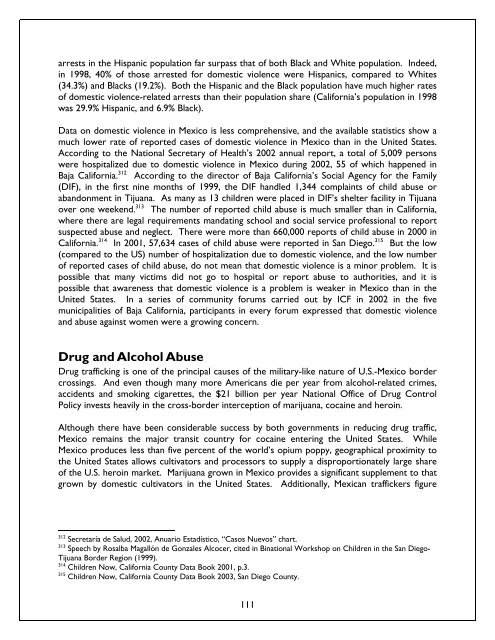Blurred Borders - International Community Foundation
Blurred Borders - International Community Foundation
Blurred Borders - International Community Foundation
Create successful ePaper yourself
Turn your PDF publications into a flip-book with our unique Google optimized e-Paper software.
arrests in the Hispanic population far surpass that of both Black and White population. Indeed,<br />
in 1998, 40% of those arrested for domestic violence were Hispanics, compared to Whites<br />
(34.3%) and Blacks (19.2%). Both the Hispanic and the Black population have much higher rates<br />
of domestic violence-related arrests than their population share (California’s population in 1998<br />
was 29.9% Hispanic, and 6.9% Black).<br />
Data on domestic violence in Mexico is less comprehensive, and the available statistics show a<br />
much lower rate of reported cases of domestic violence in Mexico than in the United States.<br />
According to the National Secretary of Health’s 2002 annual report, a total of 5,009 persons<br />
were hospitalized due to domestic violence in Mexico during 2002, 55 of which happened in<br />
Baja California. 312 According to the director of Baja California’s Social Agency for the Family<br />
(DIF), in the first nine months of 1999, the DIF handled 1,344 complaints of child abuse or<br />
abandonment in Tijuana. As many as 13 children were placed in DIF’s shelter facility in Tijuana<br />
over one weekend. 313 The number of reported child abuse is much smaller than in California,<br />
where there are legal requirements mandating school and social service professional to report<br />
suspected abuse and neglect. There were more than 660,000 reports of child abuse in 2000 in<br />
California. 314 In 2001, 57,634 cases of child abuse were reported in San Diego. 315 But the low<br />
(compared to the US) number of hospitalization due to domestic violence, and the low number<br />
of reported cases of child abuse, do not mean that domestic violence is a minor problem. It is<br />
possible that many victims did not go to hospital or report abuse to authorities, and it is<br />
possible that awareness that domestic violence is a problem is weaker in Mexico than in the<br />
United States. In a series of community forums carried out by ICF in 2002 in the five<br />
municipalities of Baja California, participants in every forum expressed that domestic violence<br />
and abuse against women were a growing concern.<br />
Drug and Alcohol Abuse<br />
Drug trafficking is one of the principal causes of the military-like nature of U.S.-Mexico border<br />
crossings. And even though many more Americans die per year from alcohol-related crimes,<br />
accidents and smoking cigarettes, the $21 billion per year National Office of Drug Control<br />
Policy invests heavily in the cross-border interception of marijuana, cocaine and heroin.<br />
Although there have been considerable success by both governments in reducing drug traffic,<br />
Mexico remains the major transit country for cocaine entering the United States. While<br />
Mexico produces less than five percent of the world’s opium poppy, geographical proximity to<br />
the United States allows cultivators and processors to supply a disproportionately large share<br />
of the U.S. heroin market. Marijuana grown in Mexico provides a significant supplement to that<br />
grown by domestic cultivators in the United States. Additionally, Mexican traffickers figure<br />
312<br />
Secretaría de Salud, 2002, Anuario Estadístico, “Casos Nuevos” chart.<br />
313<br />
Speech by Rosalba Magallón de Gonzales Alcocer, cited in Binational Workshop on Children in the San Diego-<br />
Tijuana Border Region (1999).<br />
314<br />
Children Now, California County Data Book 2001, p.3.<br />
315<br />
Children Now, California County Data Book 2003, San Diego County.<br />
111















